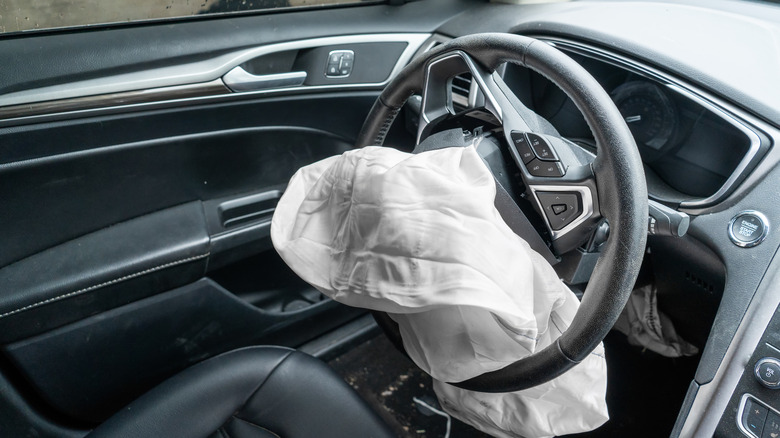One Of The Worst Automotive Recalls In History Affected Over 100 Million Cars
There are plenty of examples of deadly car recalls that have affected millions of vehicles. From Ford's infamous Pinto with its exploding fuel tank to the General Motors ignition switch scandal, history has shown us that even the best manufacturers are not immune to making mistakes of epic proportions. Takata is a name that is a worthy addition to this hall of infamy. Unlike Ford and GM, though, Takata is not a car manufacturer — rather, it's better known as a manufacturer of airbags, which are supposed to keep drivers safe in case of an accident.
Unfortunately for Takata, rather than being a safety feature, its airbags were a danger to occupants. According to the National Highway Traffic Safety Commission (NHTSA), Takata airbags are adversely affected by long-term exposure to humidity and high temperatures. In the worst cases, this can cause the airbags to explode upon deployment and throw metal debris around the cabin.
The NHTSA states that the recall affected approximately 67 million vehicles in the U.S. Worldwide, the number is thought to be about 100 million vehicles. This figure may yet rise, however, as it doesn't seem that this complex recall is over. This is witnessed by the June 2025 move by French authorities to recall 2.5 million vehicles, nearly two decades after the first recall in November 2008. Let's look at why Takata airbags are at the center of one of the worst automotive recalls in history.
Why did Takata airbags malfunction?
The first documented instance of a Takata airbag explosion occurred in Arizona in February 2007. The incident involved a 2001 Honda Civic; by 2008, another three airbag explosions had been recorded. This prompted Honda to become the first company to order a recall. The recall notice was issued on November 11, 2008, and covered a mere 3,940 cars. Ultimately, it grew to become one of Honda's biggest recalls. But to learn just why these airbags were exploding, we need to look at how airbags work and how Takata manufactured them.
During an accident, a car's systems send a signal to its airbag system, which triggers a chemical explosion that inflates the airbag with gas. All this happens in about a twentieth of a second. Takata's issues arose because it used a potentially unstable compound called ammonium nitrate as its inflator — the same compound that was used in the 1995 Oklahoma City bombing. As noted, exposure to high heat and humidity can cause these bags to explode, which is directly attributable to ammonium nitrate's tendency to become unstable in these circumstances.
Takata allegedly used ammonium nitrate because it allowed it to make a more compact airbag. However, the company has been accused of cost-cutting, manipulating safety data, and having a troubled attitude to safety. Ultimately, if it was a cost-cutting exercise, it proved to be a false economy: The recall forced the company into bankruptcy in 2017.
Just how dangerous are Takata airbags?
Takata scandal aside, according to the NHTSA, airbags saved an estimated 50,457 lives between 1987 and 2017. This makes them an incredibly successful safety device. But that doesn't diminish the severity of the Takata recall, which has been linked to 28 deaths in the U.S. and 36 globally. They've also been cited as being responsible for 400 injuries in the U.S. alone. The affected vehicle list reads like a who's who of the automobile industry and features multiple vehicles from names like BMW, Chrysler, Toyota, Ford, and Honda. If you're curious, the NHTSA has compiled a list of vehicles with an airbag-related "do not drive" warning.
There is also a wide range of dates involved. For instance, BMW USA's list of affected models goes all the way back to 2000, with the most recent vehicle made in 2015. Seat — a Volkswagen-owned car brand – has affected models up to 2017. The airbags' susceptibility to high heat and humidity means that location is also a factor in the recall. This is why the NHTSA rolled out a recall schedule based on the location of the vehicles, with Zone A covering hot and humid states like Florida and Mississippi, and Zone C including states like Alaska and New York. This is a long and troubled recall saga; if you have any doubts about a vehicle, check the NHTSA or your local equivalent for details.


